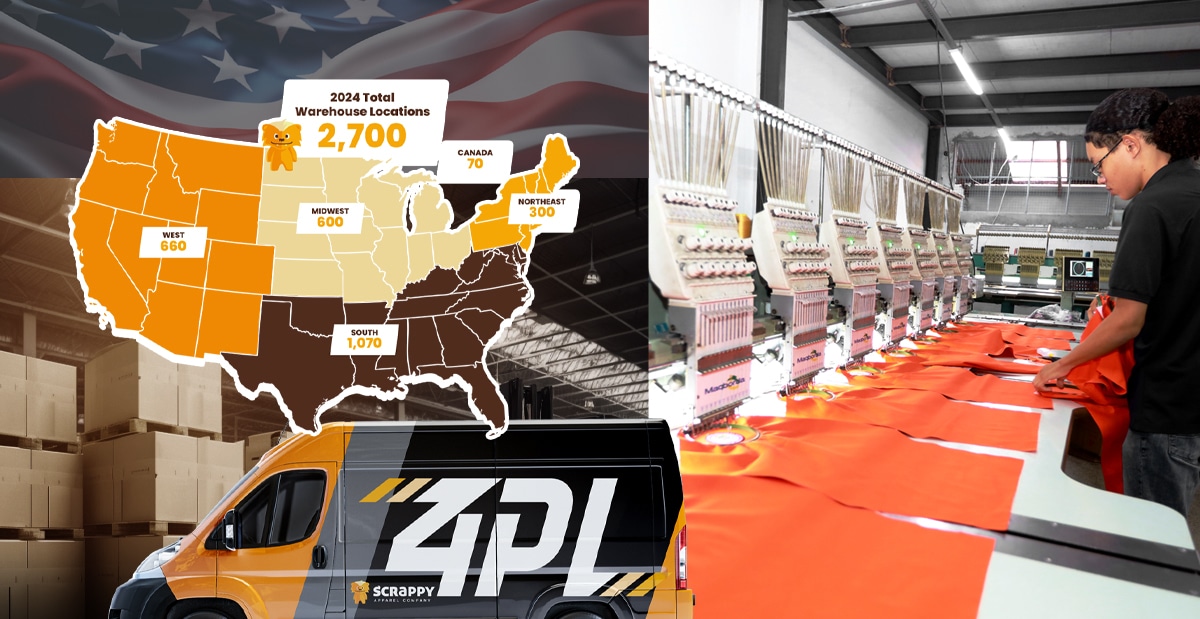How to Overcome Apparel Supply Chain Disruptions
Your supply chain is the backbone of your apparel operation. So, what happens when you face unprecedented challenges, like raw material shortages and shipping delays?
Here are just a few potential outcomes:
- Halted production timelines
- Lower quality garments
- Missed delivery deadlines
- Lost sales opportunities
- Lower profit margins
- Excess inventory or stockouts
All of these scenarios can have a significant impact on your bottom line and reputation—in both the short-term and long-term.
However, with the right strategies in place, you can mitigate the risks and overcome disruptions in your apparel supply chain. That’s what we’re going to discuss today.
Let Scrappy Apparel Streamline Your Supply Chain
Risk Assessment
The first step in overcoming supply chain disruptions is to conduct a risk assessment. This involves identifying potential risks and evaluating their likelihood and potential impact on your business.
For example:
Are you heavily reliant on a single supplier for a critical raw material? If so, what would happen if that supplier experiences production delays or goes out of business?
Consider these questions for each step in your supply chain, including:
- Sourcing
- Manufacturing
- Transportation
- Distribution
Once you have an end-to-end view of your supply chain, you can start implementing strategies to mitigate potential risks.
Plan for Contingencies
Despite your best efforts to mitigate risks, supply chain disruptions are still possible. That’s why it’s important to have contingency plans in place.
Some potential contingencies include:
- Identifying alternative suppliers and manufacturers
- Diversifying your sourcing locations
- Investing in technology solutions that provide real-time visibility into your supply chain
- Building buffer inventory to minimize the impact of unexpected shortages or delays
Having these plans in place can help minimize disruptions and keep your operations running smoothly, even during unforeseen events.
Build a Resilient Supply Chain Network
To overcome supply chain disruptions, you need to build a resilient network. This involves developing flexible production capabilities and creating redundancy in critical areas.
To overcome supply chain disruptions, you need to enhance collaboration and communication with your suppliers. This involves adopting collaborative problem-solving approaches.
Establishing Clear Communication Channels
Communication is key in any relationship, and this applies to your supply chain network as well.
Establishing clear communication channels with your suppliers, manufacturers, and logistics partners can help ensure everyone is on the same page.
Here are some ways you can enhance communication within your network:
- Implement regular check-ins or meetings with key partners
- Use technology solutions for real-time tracking and updates
- Share forecasts and demand plans to provide visibility into upcoming orders
By creating open lines of communication, you can build stronger relationships with your partners. That way, you can proactively address potential issues and quickly adapt to changes in the supply chain.
Collaborative Problem-Solving Approaches
Take charge by proactively tackling concerns head-on to minimize disruptions.
When adjustments are needed, communicate them immediately—ensure that everyone understands the reasons behind the changes and shares the updated specifications to all key partners.
Always be receptive to feedback from your manufacturers. Their expertise can provide critical insights into production and supply chain processes.
Develop Agile Inventory Management Strategies
Supply chain management doesn’t end at the 3PL warehouse.
You also need to have effective inventory management strategies in place.
This involves having a clear understanding of your inventory levels, demand forecasts, and lead times for replenishment. Here are key points to consider:
- Real-Time Inventory Monitoring: Use inventory management software to gain real-time visibility into your inventory levels. This allows you to track stock on hand, identify whether you are hitting reorder points, and avoid excess inventory that ties up resources.
- Accurate Demand Forecasting: Leveraging data analytics can improve the accuracy of your demand forecasts. By analyzing historical sales data, seasonal trends, and market conditions, you can ensure that you have the right amount of inventory on hand to meet customer demands without overstocking.
- Optimized Replenishment Processes: Understanding lead times for replenishment will help in planning orders effectively. Ensure you have a contingency plan in place for suppliers that may have longer lead times, allowing you to adjust your inventory purchases accordingly.
By focusing on these strategies, you can create a more agile inventory management system that minimizes disruptions and supports a more adaptable supply chain.
Optimize Transportation and Logistics
The final step in overcoming supply chain disruptions is to optimize your transportation and logistics processes.
On-time deliveries = satisfied customers. Streamlined logistics can help achieve that.
Here are some best practices to optimize transportation and logistics:
Monitor Delivery Times
Implement key performance indicators (KPIs) related to on-time deliveries, such as delivery accuracy and transit time.
Regularly assess these metrics to identify patterns and make necessary improvements. That way, you can fulfill your commitments to customers.
Work with Reliable Delivery Partners
Choosing the right delivery partners can significantly influence your supply chain’s performance.
Research and build relationships with logistics providers that have a proven track record of reliability and efficiency. Evaluate their ability to meet your delivery timelines as well as their responsiveness to potential disruptions.
Implement Technology for Tracking and Transparency
Real-time tracking systems can provide visibility into the status of shipments, allowing you to proactively address delays or issues before they impact delivery schedules.
Sharing tracking information with customers can also enhance transparency, improving their experience and trust in your service.
Simplify Your Supply Chain with Scrappy Apparel
At Scrappy Apparel, we understand that building and managing a reliable supply chain gets complicated quickly. Our end-to-end supply chain management solution offers you a streamlined, agile process that minimizes disruptions and maximizes efficiency.
Here are the benefits you’ll enjoy as one of Scrappy’s partners:
A Single Point of Contact
We all need more time back in our day, so why spend yours playing phone tag with multiple suppliers and partners?
With us, you gain a single point of contact who streamlines your entire supply chain—from sourcing high-quality materials to managing inventory and fulfilling orders.
This simplified approach reduces the time and effort you spend coordinating with multiple vendors. You can make quicker decisions and maintain focus on your core business objectives.
Eliminate the Chaos
By partnering with Scrappy Apparel, you’ll eliminate the chaos of juggling multiple vendor relationships.
No more worrying about price fluctuations or production delays—our team takes care of it all, so you don’t have to. Our quotes are crystal clear and transparent. No hidden fees or surprises along the way.
Our integrated solutions save you invaluable time, money, and resources, allowing you to allocate those savings back into areas that drive your business forward.
Expertise that Matters
Trust in our expertise to keep your supply chain agile and efficient.
Our team has a wealth of experience in navigating supply chain challenges, responding swiftly to changes, and identifying opportunities for improvement.
This empowers you to focus on what truly matters: growing your business, knowing your supply chain is in capable hands.





